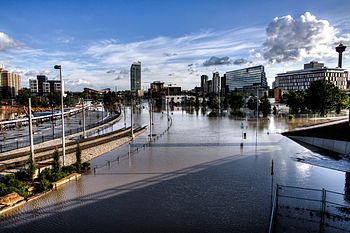2013 Alberta flood

The Downtown East Village neighbourhood of Calgary, Alberta, during the 2013 Alberta floods (June 21, 2013)
|
|
| Date | June 19 – July 12, 2013 |
|---|---|
| Location | Southern and central Alberta: Communities
Banff, M.D. of Bighorn No. 8 (Benchlands, Dead Man's Flats, Exshaw, Harvie Heights and Lac des Arcs), Black Diamond, Calgary, Canmore, Cochrane, Crowsnest Pass, Cypress County, Devon, Drumheller, M.D. of Foothills No. 31, Fort Macleod, High River, Kananaskis I.D., Lethbridge, Lethbridge County, Medicine Hat, Mountain View County, M.D. of Pincher Creek No. 9, M.D. of Ranchland No. 66, Okotoks, Red Deer, Red Deer County, Redcliff, Redwood Meadows, Rocky View County (Bragg Creek), Siksika Nation, Stoney Nation (Morley), Sundre, Tsuu T'ina Nation, Turner Valley, Vulcan County and M.D. of Willow Creek No. 26
|
| Deaths | 5 |
| Property damage | $5 billion (Estimated) ($5.22 billion in 2016 dollars) |
In the days leading up to June 19, 2013, Alberta, Canada, experienced heavy rainfall that triggered catastrophic flooding described by the provincial government as the worst in Alberta's history. Areas along the Bow, Elbow, Highwood, Red Deer, Sheep, Little Bow, and South Saskatchewan rivers and their tributaries were particularly affected. A total of 32 states of local emergency were declared and 28 emergency operations centres were activated as water levels rose and numerous communities were placed under evacuation orders.
Five people were confirmed dead as a direct result of the flooding and over 100,000 people were displaced throughout the region. Some 2,200 Canadian Forces (CF) troops were deployed to help in flooded areas in addition to the Royal Canadian Mounted Police and Alberta Sheriffs Branch response. Total damage estimates exceeded C$5 billion and in terms of insurable damages, made the 2013 Alberta floods the costliest disaster in Canadian history at $1.7 billion, until the occurrence of the 2016 Fort McMurray wildfire. Receding waters gave way to a mammoth cleanup of affected areas, aided by a spontaneous volunteer campaign in which many home owners were assisted by complete strangers.
Situated east of the Canadian Rockies, southern Alberta is a semi-arid region that does not usually receive high amounts of rainfall. A high-pressure system in northern Alberta blocked the passage to a low-pressure area to the south. This blocked circulation and easterly winds pumped humidity on the rising slopes of the Rocky Mountains foothills, causing heavy rain into the province with rainfall amounts of over 200 millimetres (7.9 in) to fall in less than two days in many regions of the province, particularly west and southwest of Calgary. In Canmore, a town in Alberta's Rockies, over 220 millimetres (8.7 in) fell in just 36 hours, nearly half of the town's annual average rainfall. In the town of High River, rainfall amounts at one weather station recorded 325 millimeteres (12.8 in) in less than 48 hours. The rain falling on already saturated ground, coupled with the steep watershed and heavy snow loads remaining in the front ranges of the Rocky Mountains, resulted in a rapid increase in the size and flow of several rivers.
...
Wikipedia
